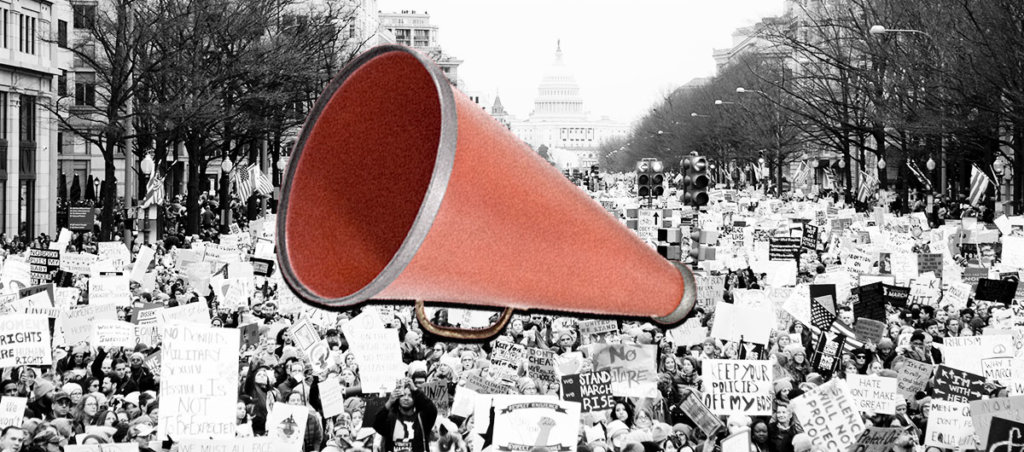The onslaught of attacks by this administration against women, people of color, immigrants, the LGBTQ community is enough to send anyone to a rage spiral. But there is purpose in that all-consuming anger.
This article was made possible because of the generous support of DAME members. We urgently need your help to keep publishing. Will you contribute just $5 a month to support our journalism?
I’ve been screaming lately.
Into a microphone during an impromptu speech at a rally an hour after Brett Kavanaugh was confirmed.
At protests, shouting “I DO NOT CONSENT!”
During a live radio interview — not modulating my voice for maximum efficacy as I usually do — letting listeners hear my visceral fury.
As a media critic, journalist, and activist, compartmentalization is my savior. I consume traumatic material, analyze it, write about it or organize around it, then hope the world improves. Actively pursuing change helps me detach from the psychic weight of injustice. Yet 90 seconds into watching Susan Collins’s “will she or won’t she?” speech, a startling thing happened: I hyperventilated, realizing a probable rapist was about to become a Supreme Court Justice. I started shaking. Air eventually returned, bringing with it the kind of sobbing that rips through your body and numbs your face and hands.
I cried from rage, fear, and humiliation, remembering the man who attempted to rape me in the late 1990s, knowing Rep. Kevin Kramer (R-ND) would dismiss my assault just as he did Dr. Christine Blasey Ford’s allegations: It was only an attempted rape, so “Nothing evidently happened,” but “even if it’s all true” it shouldn’t disqualify him. I cried over Chuck Grassley, Lindsay Graham, and Orrin Hatch apologizing to Kavanaugh, positioning him as the real victim. I cried over the Pussygrabber-In-Chief mocking survivors and hyping the “women cry rape” myth.
Every cell in my body vibrated with the knowledge that the radical Right just secured the ability to hobble progress, and reverse the clock on women’s bodily autonomy and physical safety, along with every hard-won gain for feminist, civil, and LGBTQ rights since the 1960s.
My rage was overwhelming. I was shocked — not by its depth but by its newness. I thought I understood my outrage, which has always been motivating: I told my mentally abusive father to move out when I was 8, did anti-racist youth advocacy and cursed out street harassers as a teenager, quit my first non-profit staff job at 22 with a letter documenting institutional harassment and discrimination, founded an intersectional feminist media justice organization at 27, and wrote the first book about reality TV as backlash against gender and racial justice in my mid-30s. I had no idea my rage could still have unexplored facets.
But boy, howdy, does it. When I finally stopped sobbing, I looked away from Collins’s speech, turned toward my boyfriend, and fantasized aloud about creative and immediate ways Kavanaugh might die.
That I was capable of voicing such thoughts scared me. I posted to social media that I hoped the Justice, the GOP, and the president would contract horrible diseases and die miserably and alone, slowly enough to be aware of the damage they caused but quickly enough to lose their destructive power. That sentiment was equally frightening.
I’ve never wished for anyone’s death before, not even people who’ve abused me or those I love. I never wanted to put such darkness into the universe. Something in me felt like it snapped post-Kavanaugh, a final breaking point after two years of empowered Nazis and white supremacists, attacks on press freedom, migrant babies in cages, and a sexually predatory authoritarian in the Oval Office.
Though familiar to social justice organizers, these are new emotions for millions of American women who took to the streets for the first time in January 2017, who continue to protest, confront their leaders, get arrested, run for office, and fund the resistance. The more we tap into our collective rage, the more fuel we can bring to the fire that will burn patriarchy to the ground.
A good number of these rabble-rousers didn’t previously identify with feminism. If 1992 was “The Year of the Woman,” 2018 is “The Year of Feminist Fury.” The corrupt, radical Right won this battle, but we can bring the war to every restaurant they patronize, every regressive bill they attempt to pass, every corrupt decision the newly constituted Court hands down. For as long as it takes.
